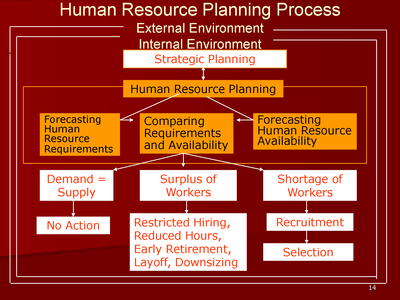The process of HRP is entirely based on the corporate plans and objectives. HRP is a continuous process of review, control and assessment. Figure clearly indicates the HRP process.

Process
Human resources planning is the process by which management ensures that it has the right personnel, who are capable of completing those tasks that help the organization reach its objectives. It involves the forecasting of human resources needs and the projected matching of individuals with expected vacancies.
Steps in implementation
Human resource planning begins with answering several questions:
What new technologies are operating and how will these affect the work system?
What is the volume of the business likely to be in the next five to 10 years?
What is the employee turnover rate, and how much, if any is avoidable?
Once these questions are answered, then you have to ask further questions that can lead to specific human resources activities such as training or hiring:
How many senior managers will we need during this time period?
What types of workers will we need, and how many?
Are there people with adequate computer skills available for meeting our projected needs?
What administrative personnel, technicians and secretaries will we need to support the additional managers and workers?
Answering these questions will also help to define the direction for the organization’s human resources strategy. For example, if forecasting suggests that there will be a strong need for more technically trained individuals, the organisation can:
Define the jobs and skills needed in some detail.
Hire and train recruiters to look for the specified skills.
Providing new training for existing employees.
Other essential measures to ensure that human resources planning is an integral part of your human resources policy include:
Creating a simple database of records with basic information on each employee (full name, date of birth, address, start date, starting wage, current wage, skills etc.)
Developing job descriptions, performance standards and appraisals.
E.W. Vetter has visualized resources planning as “a process by which an organisation should move from its current manpower position to its desired manpower position. Through planning, management strive to have the right number and right kind of people at the right places, at the right time, doing things which result in both the organisation and the individuals receiving maximum long-run benefit.”
Thus, human resource planning is a process which determines how an organisation should move from its current manpower/human resources position to its desired manpower/human resources position.
Human resource planning can be defined as the process of identifying the number of people required by an organization in terms of quantity and quality. All human resource management activities start with human resource planning. So we can say that human resource planning is the principle/primary activity of human resource management.
The process of HRP involves various steps they can be explained with the help of the following diagram.
1. Personnel demand forecast :-
This is the very first step in HRP process. Here the HRP department finds out department wise requirements of people for the company. The requirement consists of number of people required as well as qualification they must possess.
2. Personnel supply forecast :-
In this step, HR department finds out how many people are actually available in the departments of the company. The supply involves/includes number of people along with their qualification.
3. Comparison:-
Based on the information collected in the 1st and 2nd step, the HR department makes a comparison and finds out the difference. Two possibilities arise from this comparison
No difference :-It is possible that personnel requirement = personnel supplied. In this case there is no difference. Hence no change is required.
Yes, there is a difference :-There may be difference between supply and requirement. The difference may be
Personnel surplus
Personnel shortage
4. Personnel surplus :-
When the supply of personnel is more than the requirement, we have personnel surplus. We require 100 people, but have 125 people. That is we have a surplus of 25 people. Since extra employees increase expenditure of company the company must try to remove excess staff by following methods.
5. Personnel shortage :-
When supply is less than the requirement, we have personnel shortage. We require 100 people; we have only 75 i.e. we are short of 25 people. In such case the HR department can adopt methods like Overtime, Recruitment, Sub-contracting to obtain new employee.

 Follow
Follow